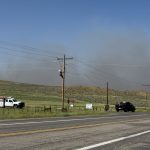Esteemed scientist tells Steamboat audience everyone has skills to help with climate action

Suzie Romig/Steamboat Pilot & Today
In a packed Bud Werner Memorial Library Hall in Steamboat Springs on Thursday evening, Jan. 19, internationally known climate scientist Katharine Hayhoe kept the science simple and relatable but the emotional connection elevated.
An audible gasp came from the audience when Hayhoe showed a data-marked map of the U.S. The colors did not indicate the significant rising global temperatures since the start of the industrial age but rather the high number of Routt County adults who believe in climate change science but are not doing as much to help with the problem.
Hayhoe, Ph.D., noted that 73% of Routt County adults think that climate change is happening and that it will harm plants and animals. That percentage marks a slight uptick to the national averages, according to 2021 studies by the University of California Santa Barbara, Utah State University and Yale Program on Climate Change Communication.
The studies show 71% of Routt County adults think global warming will harm people in developing countries; however, only 47% of county adults think global warming will harm them personally.
The climate scientist emphasized that climate change already is affecting Colorado mountain towns by creating weather that is more variable, adds more rain on snow days, shortens ski seasons, creates changes in total snowpack, facilitates more intense wildfires, endangers water resources and leads to economic stress. The average temperature in Colorado in the 1890s was 43.5 degrees compared to 46 degrees now, she said.
She said the current strong snowpack is terrific for skiing and summer water conditions, yet the changing climate is based on the long-term average of weather across 20 to 30 years.
“Weather is a single tree, and climate is the forest,” Hayhoe illustrated. “Climate is changing faster than any time of humans on the planet.”

Suzie Romig/Steamboat Pilot & Today
The studies show 45% of Routt County adults discuss global warming “at least occasionally,” which is higher than the national average of 35%. Hayhoe works to raise that level of conversation and the resulting action through her many outreach channels and her 2021 book “Saving us: A Climate Scientist’s Case for Hope and Healing in a Divided World.” A publisher asked the scientist to write the book based on her highly viewed TED talk called “The most important thing you can do to fight climate change: talk about it.”
Already in Steamboat as a keynote speaker at the Weather Summit last week, Hayhoe said she was “delighted” to have a conversation with the library audience about how everyone has the skills to help with climate action. She said scientists are good messengers to speak about climate facts, but ordinary citizens are the No. 1 best messengers for their family and friends.
“We trust peers who share our values and speak a common language,” said Hayhoe, a Canadian-born atmospheric scientist who serves as chief scientist for nonprofit The Nature Conservancy.
Hayhoe solicited audience questions through an interactive poll, which included the top-ranked query, “What is the number one thing we (Routt County) can be doing today to help us fight climate change in our community?”
“Most people say ‘it’s real and will affect me in the future,’ so talk about how it’s happening here and now, what matters to us and how we are already being affected,” Hayhoe advised.
Hayhoe said the four main ways to stop putting so much carbon pollution into the atmosphere include efficiency, clean energy, smart land use and agriculture, and behavioral change.
Efficiency means conserving energy, not being wasteful and using less fossil fuels. Clean energy means replacing fossil fuels with energy sources that do not produce heat-trapping gases in the Earth’s atmosphere. Smart land use and agriculture includes reducing emissions from deforestation and methane-belching animals and their manure. Behavioral change refers to changing systems so people do not need to use so much energy.
The scientist noted that since climate change is a threat multiplier, climate action solutions create multiple benefits such as: cleaner air and water; added protection from disasters such as storms, wildfires and floods; improved physical and mental health; more affordable and renewable energy; healthy ecosystems and foodscapes; increased stability across the world; and reduced gender, racial and socio-economic inequality.
For effective climate action steps, the scientist recommended the website for nonprofit Project Drawdown, which includes a Solutions Library with topics ranging from efficient trucks to building retrofits to net-zero buildings. Project Drawdown also features a six-part series of short videos called “Climate Solutions 101.”
Hayhoe encouraged people to take any positive step for climate action, then talk about it with friends. People should focus on their climate shadow, or how their actions and conversations can help inspire area organizations and decision-makers, she said. Residents can learn about environmental solutions that have worked for other workplaces, schools and organizations and then promote those answers in their similar circles.
To reach Suzie Romig, call 970-871-4205 or email sromig@SteamboatPilot.com.

Support Local Journalism

Support Local Journalism
Readers around Steamboat and Routt County make the Steamboat Pilot & Today’s work possible. Your financial contribution supports our efforts to deliver quality, locally relevant journalism.
Now more than ever, your support is critical to help us keep our community informed about the evolving coronavirus pandemic and the impact it is having locally. Every contribution, however large or small, will make a difference.
Each donation will be used exclusively for the development and creation of increased news coverage.










